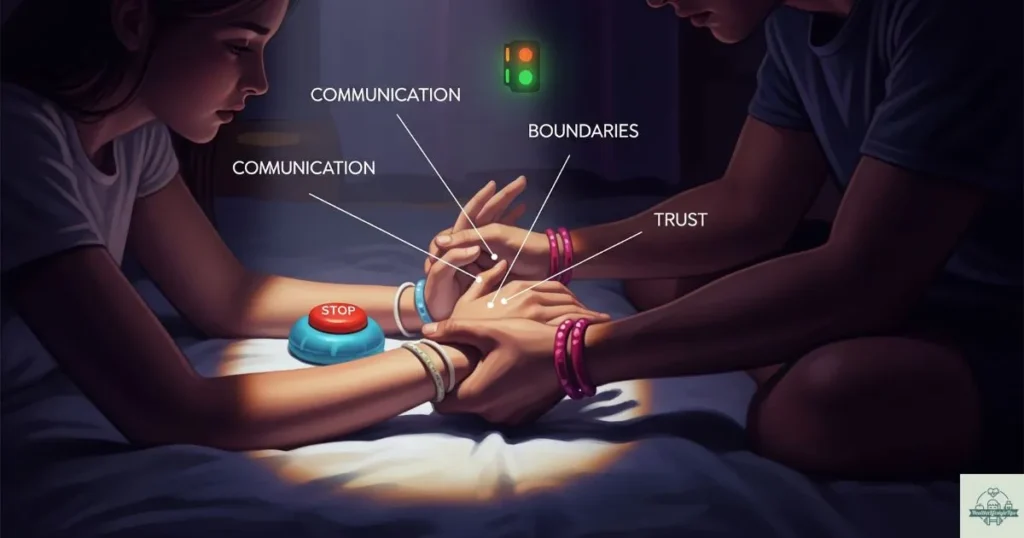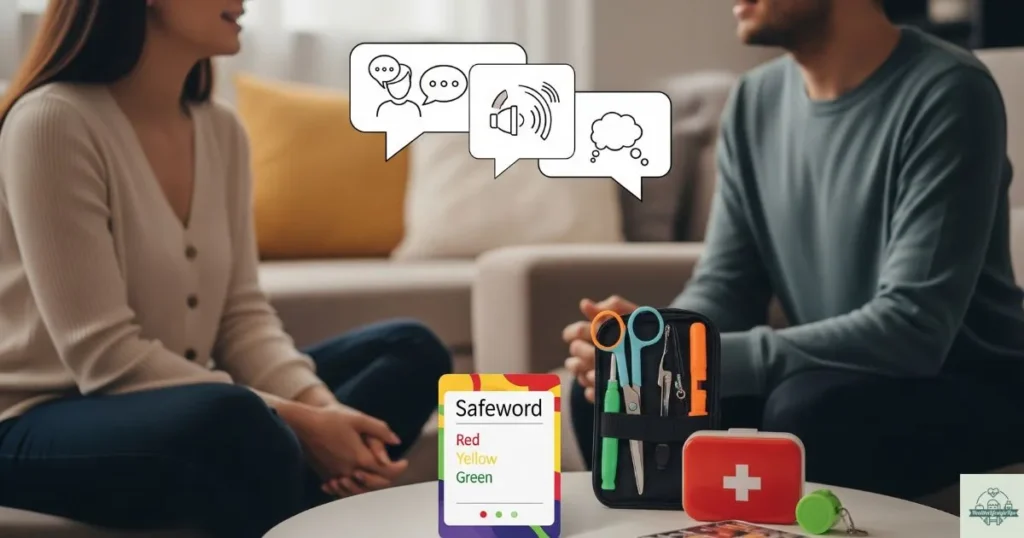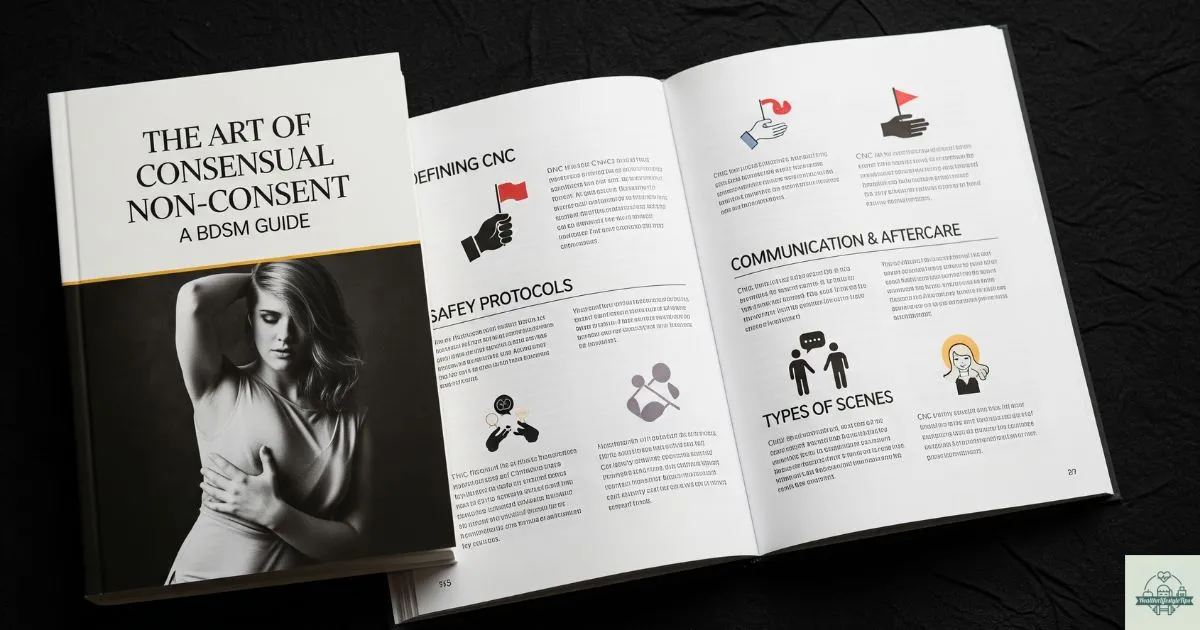Have you ever been curious about a side of relationships that feels a little wild, intense, and maybe even a bit forbidden? Let’s talk about something called Consensual Non-Consent (CNC). It might sound like a puzzle, but it’s a deeply misunderstood and popular kink that people explore to build incredible trust and connection.
At its core, CNC is a form of role-play where everyone involved agrees to act out a scene that appears to involve one person not consenting, but in reality, every single moment is planned and enthusiastically agreed upon beforehand. Think of it like a movie stunt: it looks dangerous and real, but the actors have rehearsed it, have safety measures in place, and trust each other completely. This guide will walk you through everything you need to know, from the psychology behind it to planning your first scene safely.
Understanding CNC

So, what is it about CNC that draws people in? It’s all about exploring fantasies in a safe and controlled space. Many people have fantasies about being desired so much that someone can’t resist them. CNC allows you to play out that intense feeling of being “taken” or “overpowered” without any of the real danger or harm.
The Psychology Behind CNC Fantasies
Fantasies about being forced are surprisingly common. It’s not because people secretly want to be hurt; it’s often about giving up control. In our daily lives, we make hundreds of decisions. The idea of letting go and allowing someone you trust to take the lead can feel incredibly freeing. It lets you experience thrilling emotions without any real-world consequences. It’s a way to feel desired, explore your boundaries, and step into a different role for a little while.
CNC vs. Free Use: What’s the Difference?
You might hear about another kink called “free use” and wonder if it’s the same thing. They are similar but have a key difference. Free use is an ongoing agreement where one person has permission to initiate intimacy at any time, without needing to ask in the moment. The other person has already given their consent to be available whenever their partner desires.
CNC is typically a specific, pre-planned scene focused on role-played resistance and being overpowered, with a clear start and end. Both require trust, but CNC is about performing without consent, while free use allows ongoing access based on a prior agreement.
Is CNC Normal? Debunking Myths and Misconceptions
Let’s clear the air: having CNC fantasies is normal, and plenty of people have them. A major myth is that enjoying CNC means you have unsolved issues or want actual harm. That isn’t accurate. The most important part of Consensual Non-Consent is, after all, the consent. It’s a playful activity among trusting partners, with clearly set rules, to keep everyone safe and comfortable.
Safety First: Building a Foundation of Trust

Before you even consider trying CNC, safety is the number one priority. This kind of play is built on a mountain of trust. Without it, the entire experience falls apart and can become genuinely upsetting.
What Does “Safe, Sane, and Consensual” (SSC) Mean in CNC?
You’ll often hear the phrase “Safe, Sane, and Consensual” (SSC) in BDSM communities. Here’s what it means for CNC:
- Safe: Everyone takes steps to prevent physical or emotional harm. You discuss risks and strategies for mitigating them.
- Sane: All participants are of sound mind. They understand what they are doing and can make clear decisions for themselves.
- Consensual: All parties involved have given their enthusiastic consent to participate. Consent can be withdrawn at any time, for any reason.
How to Use Risk-Aware Consensual Kink (RACK) for CNC Play
Another popular safety model is Risk-Aware Consensual Kink (RACK). This framework acknowledges that all activities carry some level of risk, but its goal is to understand and mitigate those risks. For CNC, this means talking openly about what could go wrong—a move that’s too rough, a word that triggers a bad feeling—and planning how to handle it. RACK encourages personal responsibility and open communication.
Essential Safety Tools for CNC
Preparation matters for safety. Many CNC scenes are simply role-play, but if you plan to use items like restraints, it’s wise to have safety tools nearby. Safety shears can quickly cut through rope or fabric in emergencies, and a small first-aid kit can help with minor cuts, scrapes, or bumps.
Planning Your CNC Scene
A great CNC scene doesn’t just happen; it’s carefully crafted. The planning stage is where you and your partner become co-directors of your own private movie, ensuring every detail is perfect.
How to Prepare for Your First CNC Scene
If you’re new to this, start slow. Your first “scene” could be as simple as talking through a fantasy together. Then, you might try a little bit of playful resistance during a normal intimate moment. The key is to build your comfort and trust levels gradually before moving on to a more elaborate scenario.
The Role of CNC Contracts: Should You Use One?
For some, writing down the rules in a “CNC contract” can be incredibly helpful. This isn’t a legally binding document, but a written agreement between you and your partner. It can outline your limits, safe words, and exactly what will happen in the scene. It helps ensure you’re both on the same page and can be a great way to make the negotiation process feel official and clear.
Setting Boundaries: Hard Limits, Soft Limits, and Triggers
This is the most important part of your negotiation.
- Hard Limits: These are the absolute “no-gos.” These are things that are completely off the table, regardless of the circumstances. For example, a hard limit might be no hitting in the face or no use of certain words.
- Soft Limits: These are things you might be hesitant about but are willing to explore cautiously. They are the “proceed with caution” zones.
- Triggers: These are words, actions, or situations that may evoke a genuinely negative emotional reaction, often due to past experiences or traumatic events. Be open and honest about your triggers so your partner can avoid them.
How to Negotiate a CNC Scene Like a Pro
The best negotiations are open, honest, and judgment-free. Sit down with your partner when you have plenty of time and both of you are relaxed. Talk about what you want to feel. Do you want to feel cherished and adored, or something more rugged? Discuss every detail, from the words you’ll use to the clothes you’ll wear. No question is too small or silly.
Roleplay Ideas and Scenarios
Once you’ve got your safety plan, it’s time for the fun part: deciding on your story! The possibilities for Consensual Non-Consent (CNC) scenes are endless and can be tailored to fit your exact desires.
Creative CNC Roleplay Scenarios
Here are a few classic ideas to get your imagination going:
- The Kidnapping: One partner “abducts” the other, maybe blindfolding them and playfully tying them up.
- The Interrogation: One person plays a detective or spy trying to get “information” from the other through playful intimidation.
- Rape Fantasy: This is a very common CNC scenario where partners role-play a forced encounter. Remember, this is a fantasy, and both people have given their consent and are in control of the reality of the situation.
How to Tailor CNC Scenarios to Your Comfort Level
Your scene should be perfect for you. If intense scenarios feel overwhelming, start with something lighter. Maybe it’s a “home invasion” where one partner playfully overpowers the other on the couch. You can adjust the intensity, the duration, and the activities to match what feels exciting and safe for both of you.
Incorporating Props and Costumes for Immersive CNC Play
Props and costumes can make a scene feel much more real and exciting. A simple blindfold can heighten the senses, and using silk ties instead of rope can feel softer and less intimidating for beginners. Costumes—whether it’s a specific uniform or just changing into different clothes—can help you both get into character.
Also Read: Ultimate Guide to Age Play
During the Scene: Communication and Control
Even with a perfect plan, things can change in the heat of the moment. That’s why communication during the scene is just as important as the negotiation before it.
How to Use Safe Words and Non-Verbal Signals Effectively
A safe word is a word or phrase that completely stops the scene, without question. It should be something you wouldn’t normally say during intimacy, like “pineapple” or “red light.” It’s also smart to have a non-verbal signal, like tapping the floor three times, in case you can’t speak. Remember, using a safe word is a sign of strength and self-awareness, not a sign of weakness.
Recognizing Red Flags During CNC Play
Pay close attention to your partner. If their breathing changes, their body tenses up unexpectedly, or they seem emotionally distant, it might be a red flag. The person in the “dominant” role has a huge responsibility to watch for these signs and check in, even if it means briefly breaking character. A simple “You okay?” can make all the difference.
Balancing Realism and Safety in CNC Roleplay
The goal is to make the scene feel realistic, but safety should always be the top priority. The struggle can be real, but it should never be dangerous. The words can be harsh, but they should never be genuinely cruel. It’s a delicate dance, but one that becomes easier as you build trust and learn each other’s cues. This careful balance is what makes Consensual Non-Consent (CNC) so powerful.
Aftercare: Emotional and Physical Recovery
What happens after the scene ends is one of the most crucial parts of the experience. This is called aftercare, and it’s all about ensuring everyone feels safe, cared for, and emotionally well.
Why Aftercare is Essential for CNC
CNC scenes can bring up intense emotions for both the “dominant” and “submissive” partner. The person who was “resisting” might feel vulnerable, while the person who was “taking” might feel a bit of guilt or intensity from their role. Aftercare helps you both come down from that emotional high and reconnect as loving partners.
Examples of Aftercare Activities for Both Partners
Aftercare looks different for everyone. It might include:
- Cuddling and holding each other.
- Getting a warm blanket or a glass of water.
- Talking about the scene and what you both enjoyed.
- Offering words of reassurance and love.
- Just being quiet together.
How to Debrief After a CNC Scene
A debrief is a conversation you have after the aftercare, maybe the next day. It’s a chance to talk about what worked, what didn’t, and what you might want to change for next time. Did a certain word feel amazing? Was a certain move a little too much? This feedback loop helps you make your next scene even better.
Advanced CNC Considerations
As you get more comfortable with CNC, you might want to explore deeper or more complex aspects of this kink.
How to Handle Emotional Triggers and Unexpected Reactions
Sometimes, a scene can bring up an emotion you didn’t expect. If that happens, it’s important to stop, use your safe word, and focus on aftercare immediately. Talk about what happened when you’re both calm. It doesn’t mean you failed; it just means you discovered a new boundary, which is a valuable piece of information.
CNC in Long-Term Relationships: Keeping It Fresh and Safe
In a long-term relationship, Consensual Non-Consent (CNC) can be an amazing way to keep the spark alive. But it’s easy to get complacent. Continue negotiating, especially if you want to try something new. Don’t assume your partner’s limits are the same today as they were last year.
Legal and Ethical Aspects of CNC: What You Need to Know
It’s important to be aware that from the outside, a CNC scene can be misinterpreted. Always play in a private space where you won’t be seen or heard by people who don’t understand what’s happening. Ethically, the rule is simple: if consent isn’t clear, enthusiastic, and ongoing, it’s not CNC.
FAQs
How Do I Bring Up CNC with My Partner?
Start by talking about fantasies in general. You could say, “I read an interesting article about role-playing, and it got me thinking. Have you ever fantasized about…?” Keep it light and hypothetical at first. The key is to create a safe space for an open conversation.
What Should I Do If a CNC Scene Goes Wrong?
If a scene goes wrong, the first step is to use your safe word and stop immediately. Then, shift into aftercare mode. Reassure your partner, provide comfort, and give them space if they need it. Don’t try to solve the problem at the moment. Wait until you’re both calm to debrief and figure out what happened.
Conclusion
Exploring Consensual Non-Consent (CNC) is a journey into trust, communication, and the realm of fantasy. It’s about playing with power and desire in a way that is incredibly connecting and empowering. When done with care, respect, and a whole lot of communication, it can be one of the most profound experiences you can share with a partner.
If you’re curious to learn more, consider reading books on BDSM, joining online forums with experienced community members, or even attending educational workshops. The more you know, the safer and more fulfilling your adventures will be.
